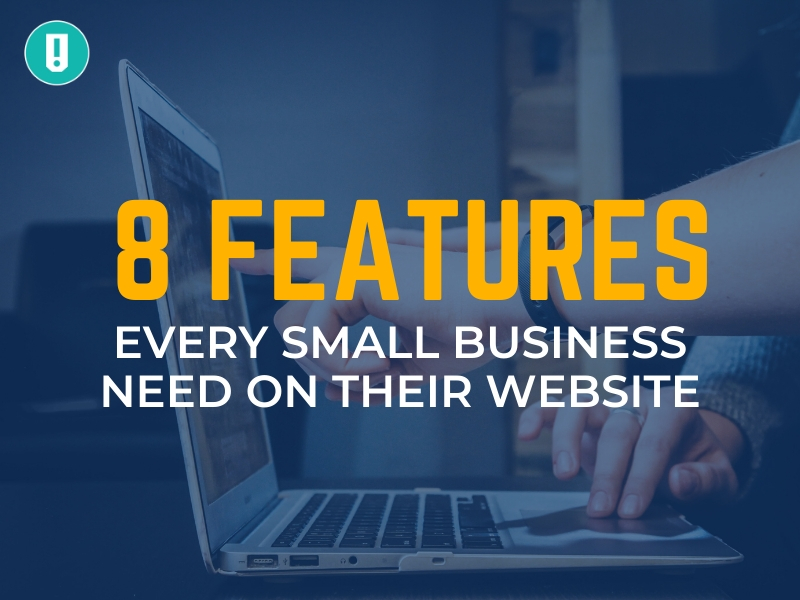Website design can be a daunting process. But in today’s digital age, a lot of people expect your business to be found online. Still, some business owners think that they don’t need a website.
What they don’t know is that it isn’t only necessary to have a website, it’s also vital that you launch your site and brand strategy to gain maximum impact.
Think of your site as a way to introduce yourself to new prospects and keep your old customers engaged.
Now, regardless of what type of business and company you might have, here are some cool features your small business website should have:
1. Information About Your Business
When it comes to introducing your business to prospects, the Four W’s are a great way to start:
- Who are you? This lets people know what your business is all about. You could share your mission statement or introduce the people who are behind your brand.
- What do you have to offer? This communicates to prospects the products and services that you have to offer, as well as how it can help them in their daily lives. Take the chance to highlight what you have to offer customers that other businesses don’t like a high-quality product, lower price range, or locally sourced materials.
- Where can people buy your goods and services? If you’re offline, then at least tell people where they could find your business. As for your website, you should also add your accepted payment gateways.
- When and how can people reach you? If you have a physical store, then make sure that you list your store hours. If you have an online store, let your customers know when your customer service is available. Make your contact information highly visible on every page of your website.
Once people already have an idea of what your business is all about, make sure that your value proposition is also communicated well on every single page of your site.
2. Simple Navigation
Just like what we always say at Sytian Website Designer Philippines, your website is basically useless without clear navigation. That said, ensure that your Contact, About Us, FAQ, and other web pages are encapsulated in simple but concise navigation.
Being too clever or cryptic about things would potentially be a turn-off for a lot of users.
Also, when you’re creating your navigation strategy, consider your call-to-action. What is it that users want to accomplish on your site? Do they want to become a member? Make a purchase? Email you for a quote? Locate your physical store? Speak with a customer representative?
Make sure that whatever your goals are, it is clear and obvious.
3. Easy-to-Find Contact Information
Include contact information or a form on your site for those who have questions. If users are reaching out to you through email, then make sure that you communicate to them in a way that they expect, and then follow through.
It also helps that you make a list of the prospective questions that users have, and then craft a Frequently Asked Questions (FAQ) section on your website. If they could easily get the answers they need, then you have one less email to answer.
The last thing that you want to happen is to lose a customer to your competitors because it was quite difficult for them to contact you.
4. Calls-to-Action
A call-to-action or CTA is an image or text that entices leads, customers, and visitors to take action. A CTA’s purpose is to guide users through their entire customer journey and walk them through the next steps.
Some examples of good CTA are:
- “Schedule a consultation.”
- “Download the ebook.”
- “Request a demo.”
Gone are the days where people simply sign up to receive emails from you. But still, a lot of people liked to be led to useful activities and resources that would help them get closer to solving their problems.
So, make sure that your CTAs are useful and relevant.
5. Original and Quality Content and Images
A lot of businesses think that publishing any type of content will do well as long as they publish it on their website, and it looks nice. But that is far from the truth.
Your site still needs to be filled with information that your readers will find helpful. That way, it is easy for them to convert to loyal customers.
If you are planning to work with someone who will write all the content for you, ensure that you give them enough information about your site and what is on its pages. It should also be easy to read and understand.
Furthermore, make sure that you regularly come up with fresh and unique content. You could use a program like Copyscape to ensure that nothing in your content is copied from other blog posts on the internet.
Make sure that your content is long enough as well, at least 700 to 800 words. That’s because Google and other search engines favor longer content, and it simply shows that you are an expert in your niche.
Images are equally important as well. Users prefer to see lots of high-quality images and consider them as part of their online experience. Make sure that these images are at their optimal size to keep your site’s loading speed at its best.
6. Customer Testimonials and Reviews
Once you manage to attract people to your site, you need to think about what you can offer them ‒ giving them good reasons why they should pick you over your competitors.
One of the best ways for them to get to know you and your business is to read online reviews and recommendations from previous clients.
Reading good experiences from other people can convince your prospects to give your products or services a try.
7. Mobile-Friendly Layout
Chances are people are walking around while reading or typing something on their smartphones. With that in mind, you have to make sure that your content is optimized for mobile devices as well.
8. Blog Content
Every site should have a blog page.
Some of the advantages so having a blog is that it drives more traffic to your website, converts that traffic into leads and sales, establishes you as a person of authority in your niche, and drives long-term results.
Keep in mind that you regularly update your blog, at least on a weekly basis. Google will reward you with higher search rankings over time if you stay consistent with your efforts.
Final Thoughts
In today’s world, simply having a web presence is not enough. You need to consider your site as an extension of your brand.
So, do not leave these key elements off of your business websites. Invest in making your site SEO friendly, mobile responsive, intuitive, and filled with rich content. That will make it stand out from the rest of the competition.







Leave A Comment